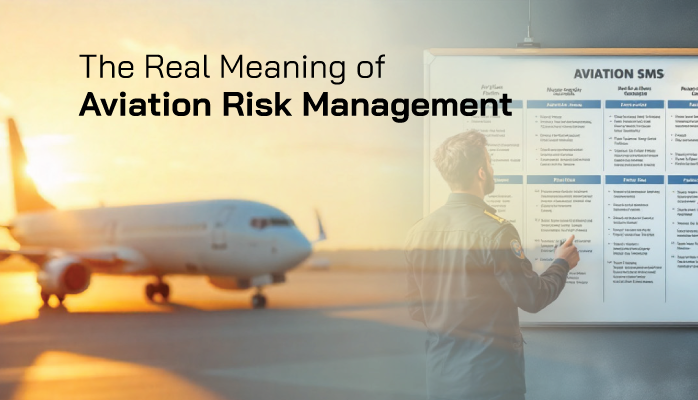“Aviation Risk Management” Is a Vague Phrase

It occurred to me recently that the phrase “aviation risk management” gets thrown around in many different contexts, both by myself and anyone else who writes about aviation safety management systems (SMS). While “aviation risk management” gives the impression of being a single, solid idea – something to attain for – in reality, it is a phrase that means many different things depending on the context.
It can be as much:
- A “thing”;
- As an adjective;
- As a process.
Pulling the big ideas together is a critical step in recognizing the strong and weak points of your aviation safety management system. It gives long-term goals to push an SMS implementation towards. And it allows aviation safety management teams to focus energy on specific, definable aspects of safety in their SMS.
Related Aviation Risk Management Articles
- 8 Stages of Safety Events in Aviation Risk Management
- 3 Main Components of Aviation Risk Management
- Most Common Aviation Risk Management Challenges at Airlines & Airports
Compliance Is the First Step, Not an End Goal
Becoming compliant is the major goal of any new aviation SMS. It’s a huge first step. In many ways, reaching a healthy level of safety compliance is a strong indicator of a well-implemented SMS, and is a testament to an aviation safety officer’s ability to manage his/her SMS in a specific direction.
Of course, compliance is only one step in a larger process of aviation safety. Where aviation SMS implementations and safety management get into trouble is accepting Compliance as the overarching end goal. Such a mindset only has the potential to cultivate a prescriptive SMS implementation, rather than a performing one.
Of course, as aviation compliance requirements change, aviation SMS will have to find ways to adapt. However, the point is that in terms of aviation safety, compliance should be curtailed to fit the unique needs of an organization's safety goals and objectives, not the other way around.
Honest About Complacency

Complacency exists in every program.
Just as SMS risk management processes and activities will never be able to eliminate risks (or should that be the goal), organizations will never be completely rid of complacent front-line employees. Let’s face it, front-line workers have jobs that are:
- Tough;
- Often physically demanding;
- Sometimes boring (which creates stress); and
- Often rote work.
So it’s no surprise that organizations will have workers – or even struggle with a whole work environment – that are apathetic to any indication of a safety program. What is the difference between this "SMS fad" and a traditional safety program where management had little participation?
From an employee's perspective, when there is a problem, ignoring it or pretending like it’s less of a problem than it actually is seems to be the easiest path. Such attitudes take time to replace and can only stall an aviation SMS's goal of continuous improvement. In this case, the "continuous improvement work" should be safety culture-oriented.
Successfully overcoming, converting, or working around complacency in aviation SMS requires that aviation safety management teams be aware and honest about the magnitude of the problem so that they can address it appropriately.
Related Articles on Complacency in Aviation SMS
- Let’s Talk Human Factors - Complacency
- What the SMS Human Factor Complacency Looks Like (With Free Newsletter Resource)
- Why Employees Don't Care About Your Aviation SMS - and How to Fix It!
Aware of Practical Drift
ICAO defines practical drift as when “…operational performance is different from baseline performance.” Baseline deployment is basically another way of saying that your policies and procedures reflect actual practice in regard to:
- The technology that is needed to reach goals;
- The necessary training for workers to fulfill their position adequately;
- The requisite employee behavioral expectations for the aviation SMS to function efficiently.
Practical drift is a natural process of changing
- technology,
- requirements, and
- relationship dynamics as an organization’s size changes.
Ideally, documentation would be updated along with such changes.
But let’s be “real” for a moment – it’s not exactly unheard of for an SMS' risk management procedures to be an improper representation of actual practice. Such organizations get away with it by instructing employees to do lip service to the documentation during audits.
Of course, I would hope that most aviation SMS make a concerted effort to revise their “work as imagined” (safety documentation) to reflect “work as actually done” on a continual basis. This is critical because technology has a way of catching up with us and an audit finding can be expected whenever auditors discover what is practiced does not align with documented risk management processes.
Information Flow Is Open
Information flow is simply another way of saying safety transparency. And where there is safety transparency, there is almost always a strong aviation safety culture. What it looks like is:
- Employees have liberal and easy access to almost all safety information stored in a safety hazard register, lessons learned library, or desensitized safety report repository;
- Management does not hoard relevant safety information;
- There are no major dependencies on information flows.
In so many words, what we are talking about is the decentralization of safety information. For this to happen, management has to be committed to keeping all except highly sensitive information open to everyone. A simple idea, a hard pill to swallow in actual practice.
Related Articles on Transparency in Aviation SMS
- A Key to Transparency in Aviation SMS
- Overcoming Resistance to Change Through Transparency in Aviation SMS
- Why Transparency Promotes Safety Culture in Aviation SMS
Adaptability
This is a big one – and you watch, this will continually be the “buzzword” of the future concerning aviation safety. In the past, aviation SMS was founded upon the idea of the Swiss Cheese model of safety, which functioned by eliminating hazards or “holes” in the fabric of the organization's risk controls.
But as safety programs become more developed, and margins of “safety improvement” become smaller and smaller, a central foundation to aviation safety will continue to lie more in the ability of an aviation SMS' ability to maintain its safety structure rather than increase safety margins. The difference in safety outlook on aviation safety between the old and new way is the same difference between
- Absorbing vs deflecting hazards
- Mitigating vs eliminating the risk
Modern aviation safety standards have come very close to what seems like the highest levels of safety possible – in terms of safety data. It seems natural then that proactive aviation risk management should focus on absorbing and mitigating issues when they DO actually arise.
Involvement

A presumption of mature aviation SMS is always involved by the entire organization, namely:
- Management is involved in supporting aviation SMS tools;
- Management responsible for monitoring SMS performance;
- Employees are involved in reporting issues;
- Safety managers are actively involved in understanding and strengthening their SMS implementation;
- Safety managers are actively involved in understanding ongoing changes in the environment.
Involvement can be encouraged or destroyed in many ways, but when discussing the lack of "aviation risk management” and “quality aviation safety”, it is almost always understood that we are also talking about lack of involvement.
An organization may spend many years developing its safety culture, but it can be destroyed within a matter of months. Sadly to say, I'm currently seeing two, historically strong operators whose safety culture is weakening due to management change.
In one case, an upper-level manager left the company, causing a major restructuring. The restructuring focuses on production and creating a company that is more interested in "doing things quickly" instead of "doing things right." This is also a major risk when safety managers or safety champions leave the company. An SMS can quickly die on the vine if there is nobody around to tend to the SMS.
In the other case of the dying safety culture, this airline had incredible resistance to the aviation SMS in their early years. After ten years, management finally evolved to fully embrace SMS and this company ended up with a best-in-class SMS implementation.
So noteworthy is this company that they had been repeatedly spotlighted in the press for their model SMS implementation. In this case, the company was sold. New management has arrived, and they seem to be interested in grooming the company for a quick flip. Management's new goals and objectives are no longer aligned with the existing safety goals and safety objectives. This creates discord that is harming their safety culture.
Have You Read
- Why Aviation Safety Managers Fail Without Dept Head Support in SMS
- How to Earn Top Management Support for Aviation SMS
- How to Regain Control of Your Aviation SMS
Final Thought: Drift Towards Complexity
The undeniable fact is that safety programs are drifting towards complexity. All you have to do is compare aviation SMS implementations to traditional safety programs 20 years ago, or even 10 years ago. The rise of many outside influences has forced "safety as a concept" to become increasingly complex - influences such as:
- Worldwide regulatory adoption of formal SMS;
- SMS software and risk management technologies;
- Outside technological influences - i.e. drones.
Complexity should be encouraged, as complex systems often have many means of mitigating and absorbing problems. Complexity will continue to grow as yet one more aspect of what aviation risk management means.
Last updated November 2025.








